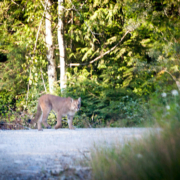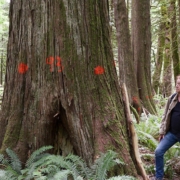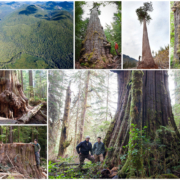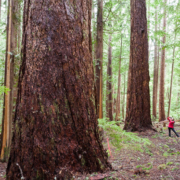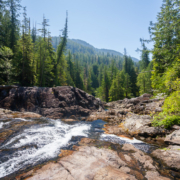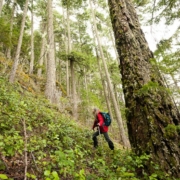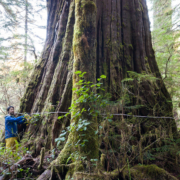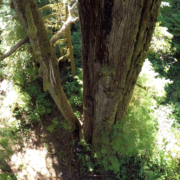Rare Lowland Old-Growth Forest at Risk – Road-building and Logging Surveys Underway at Echo Lake, the World’s Largest Night-Roosting Site for Bald Eagles, east of Vancouver
/in Media Release/by TJ WattRoad-building is scheduled to begin this week and preliminary logging surveys of the old-growth redcedars are underway by Echo Lake, an extremely rare, lowland old-growth forest about 2 hours east of Vancouver between Mission and Agassiz. Echo Lake is part of the drinking watershed for local people, is home to the largest night-roosting site for bald eagles on Earth, and harbours much wildlife including bears, cougars, bobcats, wintering black-tailed deer, osprey, numerous bats, and various Species at Risk. Local landowners and conservationists are redoubling efforts to convince the BC government to protect the endangered north and west sides of the lake.
Mission, BC – Local landowners and conservation groups are dismayed at road-building and old-growth logging plans that are underway in a community watershed at Echo Lake, an extremely rare and endangered, lowland old-growth forest between Mission and Agassiz, famous for its monumental cedars and Douglas-firs, wildlife, and hundreds of roosting bald eagles during the fall salmon run (see the Vancouver Sun https://www.vancouversun.com/Province+urged+protect+Harrison+eagles/7371025/story.html).
Landowners Stephen and Susan Ben-Oliel, who own a private land parcel on one side of the lake, and who draw their drinking water there, were informed on Monday by consultants hired by C&H Forest Products that the logging company is planning to begin construction this week of a 1400 metre long logging road in their Community Watershed. The planned road on Crown lands leads to stands of old-growth redcedars and Douglas-firs on the northwest side of Echo Lake. The couple have also discovered a series of recently flagged and spray-painted old redcedars alongside the main trail by Echo Lake in preparation for logging. Over a thousand people have now hiked the trail around Echo Lake since 2013, when the Ancient Forest Alliance began organizing guided tours through the area.
Last year, Forest Minister Steve Thomson stated that there were no logging plans for Echo Lake – See Global TV at: https://globalnews.ca/news/1906359/clear-cutting-threatens-echo-lake-eagle-colony/
However, the Ministry of Forests, Lands, and Natural Resource operations recently approved C&H Forest Products’ road building plans, although they have not approved any cutting plans at this time. Conservationists are concerned that once major sections of road are constructed, the company will be in a strengthened position to obtain approval for their logging plans in order to recuperate their costs. C&H Forest Products have a Woodlot Licence on the unprotected north and west sides of Echo Lake, while a 55 hectare Old-Growth Management Area protects the south side of the lake.
“Judging by their flagging tape and the route of their planned logging road, it appears the licensee intends to log the spectacular stands of monumental old-growth redcedars by Echo Lake – which is sort of like shooting a herd of endangered rhinos, as giant redcedars like these are almost all gone in this region,” stated landowner Stephen Ben-Oliel. “The company has informally stated that they might leave some of the individual old-growth Douglas-firs and maples, but their assurances lack detail, leave out the old-growth cedars, are purely verbal, and are not backed up by any legally-binding government regulations or laws. In addition, the risks posed by road-building and logging in the community watershed where where we and other families draw our drinking water from are also a cause for alarm.”
“Echo Lake is a globally significant area that should be a no-brainer for full government protection, especially considering how small it is, a hundred or so hectares in total size. It’s the world’s largest night-roosting site for bald eagles – that alone should make full protection of the forests in the ‘bowl’ surrounding the lake a given, not even factoring in its importance for much more biodiversity,” stated Ken Wu, Ancient Forest Alliance executive director. “We need the BC government in this election year to step forward and protect all of Echo Lake’s old-growth and mature forests on Crown lands.”
See the media release from 2013: https://16.52.162.165/news-item.php?ID=565
See spectacular images of Echo Lake Ancient Forests at: https://16.52.162.165/photos-media/echo-lake/
See a Youtube Clip at: https://www.youtube.com/watch?v=HPstV14oZ6s&feature=youtu.be
See various news media articles about Echo Lake from the Vancouver Sun, Globe and Mail, Global TV etc. at the bottom of the campaign page at: www.ProtectEchoLake.com
“The BC government needs to work with the local Woodlot Licensee, First Nations, the adjacent private land owners like myself, and conservationists to ensure the area’s legal protection. This could entail shifting the Woodlot License boundaries into an area of second-growth forest with an equivalent timber value and then expanding the Old-Growth Management Area around all of Echo Lake,” stated Susan Ben-Oliel.
More Background Info
Echo Lake is the largest night-roosting site for bald eagles on Earth, where as many as 700 bald eagles roost in the ancient Douglas-fir and cedar trees around the lake at night during the fall salmon runs. Along the nearby Chehalis and Harrison Rivers, as many as 10,000 bald eagles come to eat the spawning salmon during some years, making the area home to the largest bald eagle/ raptor concentration on Earth.
In 2013 after a campaign by local landowners and the Ancient Forest Alliance, the BC government protected 55 hectares of the old-growth forests on the Crown lands on the south side of Echo Lake in an Old-Growth Management Area (OGMA). However, they left out a similar amount of old-growth and mature forests from the OGMA on the north and west sides of the lake within a Woodlot Licence where the ancient trees can still be logged.
The area is in the traditional, unceded territory of the Sts’ailes First Nation band, who run the Sasquatch EcoLodge and whose members run eagle watching tours nearby.
Several biological surveys or “bioblitzes” have been organized by the Ancient Forest Alliance that have helped to inventory the area’s large diversity of flora and fauna. Many species at risk such as various species of bats, frogs, snails, dragonflies, and mosses have been found by biologists and naturalists. The data has been submitted to the BC Ministry of Environment’s Wildlife Species Inventory. 174 species of plant, 55 vertebrate, 153 invertebrate, and 38 fungi species were found during the two days of the 2014 bioblitz, while the 2015 bioblitz data is still being compiled. See the 2014 bioblitz media release at: https://16.52.162.165/news-item.php?ID=868
The Ancient Forest Alliance is also calling for a larger provincial plan to protect the remaining endangered old-growth forests across BC while ensuring sustainable second-growth forestry jobs.
In the Lower Mainland, about 80% or more of the original, productive old-growth forests have already been logged, including about 95% of the high productivity, valley bottom ancient forests where the largest trees grow and most biodiversity is found. See before and after maps for BC’s southern coast (Southwest Mainland and Vancouver Island) at: https://16.52.162.165/ancient-forests/before-after-old-growth-maps/
“How many jurisdictions on Earth still have trees that grow as wide as living rooms and as tall as downtown skyscrapers? What we have here is something exceptional on the planet. Our ancient forests make British Columbia truly special – while we still have them,” stated TJ Watt, Ancient Forest Alliance campaigner. “More than ever we need the BC government to have the wisdom to protect our incredibly rare and endangered old-growth forests like at Echo Lake”.
Historic Leap for Old-Growth Forests – BC Chamber of Commerce Passes Resolution for Expanded Protection
/in Media Release/by TJ WattThe WestShore Chamber of Commerce Supports Port Renfrew’s Call for the Protection of the Central Walbran Valley’s Old-Growth Forest
/in Media Release/by TJ WattFor Immediate Release
May 19, 2016
Media Release: The WestShore Chamber of Commerce Supports Port Renfrew’s Call for the Protection of the Central Walbran Valley’s Old-Growth Forest
The WestShore Chamber of Commerce (https://westshore.bc.ca/), representing almost 400 businesses in the western suburbs of Victoria and across the Capital Regional District, is supporting the Port Renfrew Chamber of Commerce’s call to the province to protect the Central Walbran Valley’s old-growth forests. In addition, the Sooke Chamber of Commerce, the Association of Vancouver Island and Coastal Communities (AVICC) representing 51 cities, towns, and regional districts, and the councils of Victoria, Metchosin, and Tofino, have also joined the call to protect the Central Walbran Valley and/or Vancouver Island’s remaining old-growth forests.
Victoria, British Columbia – Conservationists are delighted that the WestShore Chamber of Commerce, representing almost 400 businesses in the western suburbs of Victoria has issued a letter in support of the Port Renfrew Chamber of Commerce’s request to the province of British Columbia that it protect the Central Walbran Valley from old-growth logging.
Hundreds of thousands of tourists have come from across Canada, Europe, the USA, and jurisdictions around the world in recent years to visit some of Canada’s largest trees on southern Vancouver Island, near the town of Port Renfrew. Visitors are coming to see the Avatar Grove, Red Creek Fir (the world’s largest Douglas-fir tree), Big Lonely Doug (Canada’s 2nd largest Douglas-fir tree), San Juan Spruce (until recently Canada’s largest Sitka spruce tree – its top broke off in a recent storm unfortunately), Harris Creek spruce (one of the largest Sitka spruce trees in Canada), and the Central Walbran Valley.
The growing numbers of visitors coming to see ancient forests are supporting local businesses as they pay for meals, accommodations, transportation, entertainment, and services, including in the Victoria region, on their way to and from Tall Tree hotspots.
• See spectacular photos of the Walbran at: www.ancientforestalliance.org/photos.php?gID=7
And https://www.facebook.com/media/set/?set=a.886074168153838.1073741889.823970554364200&type=3
And https://www.facebook.com/media/set/?set=a.973573459403908.1073741896.823970554364200&type=3
• See a recent Youtube clip using drone footage over the Central Walbran at: www.youtube.com/watch?v=lyMPXHOjlK0
• See this 2012 video when a similar attempt to log near Castle Grove was held off, only to return recently: www.youtube.com/watch?v=lHnG_sC4oms
“Our understanding is that old growth forests represent a vital part of our multi-billion dollar coastal tourism industry, and the Walbran Valley is a key area for preservation due to its spectacular beauty, gigantic trees, and accessibility. Every year tourists are attracted to the area from around the world to explore the wild west coast, including some of the tallest trees in the world. This increasing eco-tourism generates revenue every year and directly supports local businesses throughout the region as visitors pay for meals, accommodations, transportation, and entertainment on their way to and from Tall Tree hotspots. We fully expect that West Shore businesses are currently benefiting from this tourist traffic,” stated Joshua Schmidt, Projects & Relations Manager for the WestShore Chamber of Commerce.
“Our temperate coastal rainforests are home to about the greatest per hectare biomass and some of the biggest trees in the world. As old growth forests continue to be logged worldwide the local forests we preserve will only increase in demand and value. Our belief at the WestShore Chamber is that the ecological and economic value of protecting these last old growth forests far exceeds the monetary value of its lumber.”
The Central Walbran Valley’s old-growth temperate rainforest has long been an area of public interest since hiking trails were built in the valley in 1990. In 1994, the BC government protected the Lower Walbran Valley, about 5500 hectares, as part of the larger Carmanah-Walbran Provincial Park, but left out the Central Walbran Valley (500 hectares) and the Upper Walbran Valley (7,000 hectares) from the park. Since then, most of the Upper Walbran has been heavily tattered by logging, but the Central Walbran remains largely intact. However, eight new cutblocks are planned in the Central Walbran, of which one (cutblock 4424) has been approved by the province. The Central Walbran Valley lies on Crown (public) land in the territory of the Pacheedaht band in Tree Farm Licence 46 held by licensee Teal-Jones.
On BC’s southern coast (Vancouver Island and the southwest mainland), 75% of the original, productive old-growth forests have already been logged, including over 90% of the valley bottoms where the largest trees grow. 3.3 million hectares of productive old-growth forests once stood on the southern coast, and today 860,000 hectares remain, while only 260,000 hectares are protected in parks and Old-Growth Management Areas. Second-growth forests now dominate 75% of Vancouver Island’s productive forest lands, including 90% of southern Vancouver Island, and can be sustainably logged to support the forest industry. See maps and stats at: www.ancientforestalliance.org/old-growth-maps.php
Over the past few months, the Port Renfrew, Sooke, and WestShore Chambers of Commerce have spoken up for the protection of the old-growth forests in the Walbran Valley, while the Association of Vancouver Island and Coastal Communities (AVICC) and the councils of Victoria, Metchosin, and Tofino have also passed resolutions for the protection of the Walbran or all of Vancouver Island’s remaining old-growth forests.
Old-Growth Momentum Grows as Businesses, City Councils, and Naturalists Speak Up & Renowned Filmmaker Comes to Port Renfrew
/in Media Release/by TJ WattThe Port Renfrew and Sooke Chambers of Commerce, the town councils of Metchosin, Victoria, and Tofino, and the Federation of BC Naturalists (BC Nature) have joined conservation groups in calling on the BC government to protect Vancouver Island’s old-growth forests in the Walbran Valley. In addition, renowned two-time Sundance filmmaker Joe Callander whose documentaries have been featured in the New York Times is on Vancouver Island to do a story about the old-growth forests around Port Renfrew.
Interest and concern for the fate of Vancouver Island’s endangered old-growth forests is on the rise, as a renowned filmmaker and his crew arrived earlier this week from the US to do a piece about the old-growth forests around Port Renfrew. In addition, a growing and diverse base of businesses, municipal councils, and natural history associations have joined the chorus of concerned citizens calling on the province to protect the endangered old-growth forest in the Central Walbran Valley on Vancouver Island near Port Renfrew.
Two-time Sundance filmmaker Joe Callander has been in Port Renfrew, Lake Cowichan, and Duncan this past week with the Ancient Forest Alliance and various forestry workers, business leaders, and scientists to document the endangered old-growth forests and forest industry in the area. Callander’s award-winning documentary work has been shown at over 30 festivals globally, as well as being featured in the New York Time’s Op-docs section on NYTimes.com. The New York Times has the largest circulation of any metropolitan newspaper in the USA, as well as over one million paying digital-only subscribers for its online content.
The Sooke and Port Renfrew Chambers of Commerce, the Metchosin, Tofino, and Victoria councils, and the Federation of BC Naturalists (the umbrella organization representing 53 naturalist clubs, encompassing 6000 members) have all joined the call for the BC government to protect the endangered old-growth forests of the Central Walbran Valley. The Metchosin council resolution calls on the BC government to amend the 1994 Vancouver Island Land Use Plan to protect the remaining old-growth forests across Vancouver Island, which would include the Walbran Valley.
Near Port Renfrew, the 500 hectare Central Walbran Ancient Forest is part of the 13,000 hectare Walbran Valley, of which about 5500 hectares of the valley is protected within the Carmanah-Walbran Provincial Park and 7500 hectares of the watershed lies outside of the park. About 2600 hectares lies in a “Special Management Zone” (including the 500 hectare Central Walbran), where the size of clearcuts is smaller but which still allows for most of the old-growth forests to be logged. The Central Walbran is the last, largely intact portion of the valley outside of the park, while much of the rest has been highly fragmented and tattered by clearcuts to different degrees. Teal-Jones has 8 cutblocks planned for the Central Walbran Valley, of which one, Cutblock 4424, has been granted a cutting permit by the Ministry of Forests, Lands, and Natural Resource Operations. The company recently stated that they will defer logging plans in the Central Walbran Valley for now, a welcome step forward. The company is actively logging in other parts of the Special Management Zone at this time and protesters have sporadically been blockading their logging operations in recent months. The Walbran Valley is in the unceded territory of the Pacheedaht band in Tree Farm Licences 44 and 46 on Crown lands.
Port Renfrew, formerly a logging town, has been transformed in recent years into a big tree tourism destination as hundreds of thousands of tourists have come from around the world to visit some of Canada’s largest trees in the nearby Avatar Grove, the Red Creek Fir (the world’s largest Douglas-fir tree), Big Lonely Doug (Canada’s 2nd largest Douglas-fir tree), San Juan Spruce (until recently Canada’s largest Sitka spruce tree – its top broke off in a recent storm unfortunately), the Harris Creek spruce (one of the largest Sitka spruce trees in Canada), and the Central Walbran Valley.
• See spectacular photos of the Walbran.
• See the Port Renfrew Chamber of Commerce’s statement for the Walbran here.
• See the Sooke Chamber of Commerce’s Walbran statement here.
• See the Victoria city council motion for the Walbran here.
• See a recent Youtube clip using drone footage over the Central Walbran.
“The publicity about the old-growth forests near Port Renfrew in recent years has brought in a flood of visitors from Europe, the USA, Canada, and diverse countries to visit Port Renfrew. This has especially been true since the protection of the Avatar Grove in 2012. Big tree tourism has increased the total flow of dollars spent in Port Renfrew, in our rental accommodations, restaurants, grocery stores, and businesses in general. Along with sport fishing, old-growth forest tourism has become a staple of our local economy,” states Dan Hager, president of the Port Renfrew Chamber of Commerce. “Recently, increasing numbers of visitors are heading through town to visit the Central Walbran Valley to see its old-growth forest. If the Central Walbran were to be protected, it would be a great addition to our town’s repertoire of big tree attractions.”
“The Central Walbran is one of the most magnificent places that anyone could visit. With its gargantuan trees, emerald-coloured swimming holes, amazing waterfalls, and perfect camping areas, in all of my experiences the Walbran is virtually unmatched for recreational and scenic grandeur in the world. To riddle the whole area with clearcuts and giant stumps would be the lowest, worse use of a place like this,” states Ken Wu, Ancient Forest Alliance executive director.
“The Central Walbran Valley is truly exceptional in so many ways. It has the most extensive, densely-packed groves of old-growth western redcedars in the country – including some of the near-largest on record, such as the Tolkien and Castle Giants,” stated TJ Watt, Ancient Forest Alliance photographer and campaigner. “Not only are old-growth forests important for the climate, but also for tourism, endangered species, clean water, wild salmon, and many First Nations cultures.”
“The old growth forests of the Walbran Valley are very important biologically for the great variety of plants and animals living there – some of which are at risk such as the Queen Charlotte Goshawk and Marbled Murrelet. The second growth forests which replace the old growth lack much of the biodiversity present in old growth”, stated Eric Marshall, president of Cowichan Valley Naturalists.
Ancient Forest Alliance campaigners recently located and measured two huge western redcedar trees, one of which makes it into the top 10 widest redcedars in BC according to the BC Big Tree Registry, in the Central Walbran Valley – the 4.6 metre (15 feet) wide “Tolkien Giant” and the “Karst Giant”. See: www.ancientforestalliance.org/news-item.php?ID=944
The recent agreement in BC’s northern coastal rainforest, the Great Bear Rainforest, where 85% of the old-growth forests will be protected in a combination of legislated parks, conservancies, and forest reserves (through Ecosystem-Based Management), sets a science-based precedent to increase protection now for BC’s southern rainforest – on Vancouver Island and the southern Mainland Coast, where only 8% of the original, productive old-growth forests are protected in parks and conservancies (6%) and Old-Growth Management Areas (2%).
The Ancient Forest Alliance is calling on the province to protect its endangered old-growth forests, ensure a sustainable second-growth forest industry, and end the export of raw, unprocessed logs to foreign mills in order to support BC forestry jobs. An Old-Growth Protection Act has been developed by the University of Victoria’s Environmental Law Centre for the Ancient Forest Alliance. See: https://www.elc.uvic.ca/wordpress/wp-content/uploads/2015/01/An-Old-Growth-Protection-Act-for-BC_2013Apr.pdf
On BC’s southern coast (Vancouver Island and the southwest mainland), 75% of the original, productive old-growth forests have already been logged, including over 90% of the valley bottoms where the largest trees grow. 3.3 million hectares of productive old-growth forests once stood on the southern coast, and today 860,000 hectares remain, while only 260,000 hectares are protected in parks and Old-Growth Management Areas. www.ancientforestalliance.org/old-growth-maps.php
Support Grows Among Major Conservation Groups for a Provincial Fund to Buy New Parks
/in Media Release/by TJ Watt
For Immediate Release – January 21, 2016
Support Grows Among Major Conservation Groups for a Provincial Fund to Buy New Parks
16 major conservation and recreation organizations call on the BC government to establish a $40 million/year fund to purchase and protect endangered ecosystems on private lands.
Momentum is growing as 16 major BC conservation and recreational groups have now signed onto the call for the BC government to establish a dedicated provincial fund that can be used to purchase and protect endangered private lands of high environmental and recreational significance.
A variety of proposed funding mechanisms for a BC Natural Lands Acquisition Fund (aka “Park Acquisition Fund”) are detailed in a recently released report (www.elc.uvic.ca/wordpress/wp-content/uploads/2015/12/FindingMoneyForParks-2015-02-08-web.pdf) prepared for the Ancient Forest Alliance by the University of Victoria’s Environmental Law Centre (ELC), which calls on the province to establish an annual $40 million fund.
The organizations signed on include:
- Ancient Forest Alliance
- BC Nature
- Canadian Parks and Wilderness Society – BC Chapter
- Cariboo Chilcotin Conservation Society
- Federation of Mountain Clubs of BC
- ForestEthics Solutions
- Friends of the Nemaiah Valley
- Habitat Acquisition Trust
- North Columbia Environmental Society
- Port Alberni Watershed-Forest Alliance
- Sierra Club of BC
- Skeena Wild Conservation Trust
- Trails Society of BC
- Wilderness Committee
- Wildsight
- Valhalla Wilderness Society
The report, Finding the Money to Buy and Protect Natural Lands, provides a “menu” of possible ways that funds can be allocated or generated for a dedicated fund to purchase vital green spaces and natural areas from willing sellers of private lands. These mechanisms include:
- $10 to $15 million per year by simply recapturing the windfall that the beverage industry enjoys when consumers fail to redeem container deposits, an approach nicknamed “pops for parks”.
- Many millions more could be raised by emulating the most important mechanism for park funding in the US – a special tax on non-renewable resources like oil and gas. Numerous North American governments have ruled that it is fair to require industries using up non-renewables to compensate future generations – and permanently protect other natural resources.
- Funds from a tax on real estate speculation. Currently Vancouver real estate is becoming unaffordable, in part because of speculation in the housing market. Some are proposing a specially designed tax to curb speculation. Fortuitously, such a tax could provide generous funding for acquisition of natural areas – areas which will be needed to serve our growing population.
The above initiatives could be combined with one or more of the many other proven mechanisms for park funding. This could include: dedication of funds from the sale of Crown lands, property transfer taxes, income tax check-offs, sales of environmental licence plates, gas taxes, sales taxes, taxes and fines on environmentally harmful products and actions, and a variety of other fees and taxes.
About 5% of British Columbia’s land base is private, where new protected areas require the outright purchase of private lands from willing sellers, while 95% is Crown (public) lands where new protected areas are established by government legislation. However, a high percentage of BC’s most endangered and biologically diverse and rich ecosystems are found on private lands – which tend to be found in temperate lower elevations and valleys where most humans live. As a result, private lands are disproportionately important for conservation efforts in BC. In particular, southeastern Vancouver Island, the Gulf Islands, the Lower Mainland, the Sunshine Coast, and the Okanagan Valley contain much of the private lands in BC, the greatest concentrations of endangered species, and the most heavily visited natural areas, and would benefit the most from such a fund.
“Many regional districts in BC already have dedicated land acquisition funds to protect green spaces, such as the Capital Regional District in the Greater Victoria region”, stated Ken Wu, Ancient Forest Alliance executive director. “The BC government should do its part and step forward with a fund to purchase endangered ecosystems, old-growth forests, drinking watersheds and areas of high recreational and scenic value on private lands for future generations of British Columbians. While private citizens, land trusts, and environmental groups can help, they simply don’t have enough funds to purchase enough of the lands at risk in a timely manner before their demise, in most cases. Only governments have those kinds of funds.”
“We’ve outlined a menu of practical funding options that are used by governments across North America to purchase private lands for conservation. Some mechanisms don’t even require additional taxes — such as the so-called ‘pops for parks’ funding which simply captures a current industry windfall from unredeemed beverage container proceeds,” stated Calvin Sandborn, Legal Director of the University of Victoria’s Environmental Law Centre. “Such a fund could remedy many land-use disputes and environmental concerns — while permanently enhancing the tourism economy and quality of life for all British Columbians.”
A $40 million fund to expand conservation lands would amount to less than one tenth of 1% of BC’s $40 billion annual provincial budget (ie. 1/1000th). Studies have shown that for every $1 invested by the government in BC’s provincial park system, another $9 is generated in the provincial economy as visitors spend their funds in local restaurants, campsites, motels, grocery stores, gas stations, etc.
The provincial Natural Lands Acquisition Fund would be similar to the park or land acquisition funds of various regional districts in BC which are augmented by the fundraising efforts of private citizens and land trusts. The Land Acquisition Fund of the Capital Regional District of Greater Victoria has been foundational in helping to protect endangered ecosystems and lands of high recreational and scenic value. The fund generates about $3.7 million each year and has contributed approximately $35 million dollars to the purchase of almost 4500 hectares of land around Victoria since its establishment in the year 2000. The CRD’s funds are raised through an average $20-per-household levy each year and has been pivotal for protecting lands of high environmental and/or recreational value at Jordan River, the Sooke Hills, Sooke Potholes, adjacent to Thetis Lake Park, and on Mount Maxwell on Salt Spring Island. See: https://www.crd.bc.ca/docs/default-source/parks-pdf/summary-of-2014-regional-parks-land-acquisition-fund.pdf?sfvrsn=2
Port Renfrew Chamber of Commerce Calls for the Protection of the Central Walbran Valley’s Old-Growth Forest
/in Media Release/by TJ WattPort Renfrew, BC – Conservationists are delighted that the Port Renfrew Chamber of Commerce, representing 73 businesses in the region, has issued a statement to the provincial government requesting that it protect the Central Walbran Valley from old-growth logging. Port Renfrew, formerly a logging town, has been transformed in recent years into a big tree tourism destination as hundreds of thousands of tourists have come from around the world in recent years to visit some of Canada’s largest trees in the nearby Avatar Grove, the Red Creek Fir (the world’s largest Douglas-fir tree), Big Lonely Doug (Canada’s 2nd largest Douglas-fir tree), San Juan Spruce (until recently Canada’s largest Sitka spruce tree – its top broke off in a recent storm unfortunately), the Harris Creek spruce (one of the largest Sitka spruce trees in Canada), and the Central Walbran Valley.
• See the Port Renfrew Chamber of Commerce's statement for the Walbran here: https://www.dropbox.com/s/qjstakjrvbf8jsh/PRChamberToProtectWalbran.pdf?dl=0
• See spectacular photos of the Walbran at: www.ancientforestalliance.org/photos.php?gID=7
• See a recent Youtube clip using drone footage over the Central Walbran at: www.youtube.com/watch?v=lyMPXHOjlK0
• See 2012 video (when a similar attempt to log by the Castle Grove was held off…only to return) at: www.youtube.com/watch?v=lHnG_sC4oms
“The publicity about the old-growth forests near Port Renfrew in recent years has brought in a flood of visitors from Europe, the USA, Canada, and diverse countries to visit Port Renfrew. This has especially been true since the protection of the Avatar Grove in 2012. Big tree tourism has increased the total flow of dollars spent in Port Renfrew, in our rental accommodations, restaurants, grocery stores, and businesses in general. Along with sport fishing, old-growth forest tourism has become a staple of our local economy,” states Dan Hager, president of the Port Renfrew Chamber of Commerce. “Recently, increasing numbers of visitors are heading through town to visit the Central Walbran Valley to see its old-growth forest. If the Central Walbran were to be protected, it would be a great addition to our town’s repertoire of big tree attractions.”
The Central Walbran Valley’s 500 hectare tract of lush old-growth temperate rainforest has long been an area of public interest since hiking trails were built in the valley in 1990. In 1994, the BC government protected the Lower Walbran Valley, about 5500 hectares, as part of the larger Carmanah-Walbran Provincial Park, but left out the Central Walbran Valley (500 hectares) and the Upper Walbran Valley (7,000 hectares) from the park. Since then, most of the Upper Walbran has been heavily tattered by logging, but the Central Walbran remains largely intact. However, Teal-Jones is planning eight new cutblocks in the Central Walbran, of which one (cutblock 4424) has been approved by the province. The Central Walbran Valley lies on Crown (public) land in the territory of the Pacheedaht band in Tree Farm Licence 46 held by Teal-Jones.
“The Central Walbran Valley is truly exceptional in so many ways. It has the most extensive, densely-packed groves of old-growth western redcedars in the country – including some of the very largest on record, such as the Tolkien and Castle Giants,” stated TJ Watt, Ancient Forest Alliance photographer and campaigner. “I've personally brought tourists to see the rainforests of Central Walbran Valley who had flown all the way from Europe to see these specific ancient trees. It’s truly one of the grandest old-growth forests on planet Earth and it's time for it to be fully protected.”
“The Central Walbran is seriously one of the most scenic and spectacular places anybody could visit. With its gargantuan trees, emerald-coloured swimming holes, amazing waterfalls, and perfect camping areas, in all of my experiences the Walbran is virtually unmatched for recreational and scenic grandeur in the world. It’s just the perfect place to visit, and to riddle the whole area with clearcuts and giant stumps would be the lowest, worse use of a place like this,” states Ken Wu, Ancient Forest Alliance executive director.
Ancient Forest Alliance campaigners recently located and measured two huge western redcedar trees, one of which makes it into the top 10 widest redcedars in BC according to the BC Big Tree Registry, in the Central Walbran Valley – the 4.6 metre (15 feet) wide “Tolkien Giant” and the “Karst Giant”. See: www.ancientforestalliance.org/news-item.php?ID=944
About 75% of the original productive old-growth forests have been logged on southern Vancouver Island, including over 90% of the valley bottoms where the largest trees grow, while about 8% is protected in parks and Old-Growth Management Areas. See maps and stats at: www.ancientforestalliance.org/old-growth-maps.php
The Ancient Forest Alliance is calling on the BC government to protect our endangered old-growth forests, ensure the sustainable logging of second-growth forests, end the export of raw logs, and assist in the retooling and development of sawmills and value-added facilities to handle second-growth logs.
Conservationists Call for Innovative Fund to Buy New Parks
/in Media Release/by TJ WattVictoria, BC – Conservationists are calling on the BC government to establish a Natural Lands Acquisition Fund. In a new report prepared for the Ancient Forest Alliance, the UVic Environmental Law Centre (ELC) is calling on the Province to establish an annual $40 million Natural Lands Acquisition Fund to purchase and protect endangered ecosystems on private lands.
The report, Finding the Money to Buy and Protect Natural Lands, provides a “menu” of possible ways that funds can be allocated or generated for a dedicated fund to purchase vital green spaces and natural areas from willing sellers of private lands. These mechanisms include:
- $10 to $15 million per year by simply recapturing the windfall that the beverage industry enjoys when consumers fail to redeem container deposits, an approach nicknamed “pop for parks”.
- Many millions more could be raised by emulating the most important mechanism for park funding in the US – a special tax on non-renewable resources like oil and gas. Numerous North American governments have ruled that it is fair to require industries using up non-renewables to compensate future generations – and permanently protect other natural resources.
- Funds from a tax on real estate speculation. Currently Vancouver real estate is becoming unaffordable because of speculation in the housing market. Some are proposing a specially designed tax to curb speculation. Fortuitously, such a speculation tax could provide generous funding for acquisition of natural areas – areas which will be needed to serve our growing population.
The above initiatives could be combined with one or more of the many other proven mechanisms for park funding. This could include dedication of funds from the sale of Crown lands, property transfer taxes, income tax check-offs, sales of environmental licence plates, gas taxes, sales taxes, taxes and fines on environmentally harmful products and actions, and a variety of other fees and taxes.
“Many regional districts in BC already have dedicated land acquisition funds to protect green spaces,” says Ken Wu, Ancient Forest Alliance co-founder. “The BC government should do its part and step forward with a fund to purchase endangered ecosystems, old-growth forests, drinking watersheds and areas of high recreational and scenic value on private lands for future generations of British Columbians. While private citizens, land trusts, and environmental groups can help, they simply don’t have enough funds to purchase enough of the lands at risk in a timely manner before their demise, in most cases. Only governments have those kinds of funds.”
“We’ve outlined a menu of practical funding options that are used by governments across North America to purchase private lands for conservation. Some mechanisms don’t even require additional taxes — such as the so-called ‘pops for parks’ funding which simply captures a current industry windfall from unredeemed beverage container proceeds,” stated Calvin Sandborn, Legal Director of the University of Victoria’s Environmental Law Centre. “Such a fund could remedy many land-use disputes and environmental concerns — while permanently enhancing the tourism economy and quality of life for all British Columbians.”
A $40 million fund to expand conservation lands would amount to less than one tenth of 1% of BC’s annual provincial budget (ie. 1/1000th) of $40 billion. Studies have shown that for every $1 invested by the government in BC’s provincial park system, another $9 is generated in the provincial economy as visitors spend their funds in local restaurants, campsites, motels, grocery stores, gas stations, etc.
The provincial Natural Lands Acquisition Fund would be similar to the park or land acquisition funds of various regional districts in BC which are augmented by the fundraising efforts of private citizens and land trusts. The Land Acquisition Fund of the Capital Regional District of Greater Victoria has been foundational in helping to protect endangered ecosystems and lands of high recreational and scenic value. The fund generates about $3.7 million each year and has spent over $35 million dollars to purchase over 4500 hectares of land around Victoria with its partners since its establishment in the year 2000. The CRD’s funds are raised through an average $20-per-household levy each year and has been pivotal for protecting lands of high environmental and/or recreational value at Jordan River, the Sooke Hills, Sooke Potholes, adjacent to Thetis Lake Park, and on Mount Maxwell on Salt Spring Island.
Some endangered ecosystems and/or forests on private forest lands that a BC Natural Lands Acquisition Fund could help protect right now include:
- Mount Horne, the mountainside above the world-famous Cathedral Grove, Canada’s most famous old-growth forest. Island Timberlands has roaded the mountainside above the park in preparation for potential logging.
- McLaughlin Ridge, an endangered old-growth forest in the drinking watershed of Port Alberni, home to the endangered Queen Charlotte goshawk and considered the finest deer wintering range on southern Vancouver Island. Owned by Island Timberlands.
- Muir Creek’s old-growth forest, near Sooke, and the Koksilah River old-growth forest near Shawnigan Lake, owned by TimberWest.
- The Stillwater Bluffs and Day Road Forest, owned by Island Timberlands, on the Sunshine Coast.
…and hundreds of other significant natural areas on private lands across the province.
About 5% of British Columbia’s land base is private, where new protected areas require the outright purchase of private lands from willing sellers, while 95% is Crown (public) lands where new protected areas are established by government legislation. However, a high percentage of BC’s most endangered and biologically diverse and rich ecosystems are found on private lands – which tend to be found in temperate lower elevations and valleys where most humans live. As a result, private lands are disproportionately important for conservation efforts in BC.
Conservationists Measure Near Record-Size Cedar in the Endangered Central Walbran Valley
/in Media Release/by TJ WattDrones used in BC’s Old-Growth Forest Campaigns – Walbran Valley conflict escalates
/in Media Release/by TJ WattInteresting links
Here are some interesting links for you! Enjoy your stay :)Pages
- ACTION ALERT: Tell the NDP government FRPA amendments must protect old-growth forests
- AFA Policy Recommendations – 2025
- Ancient Forests
- BC Protected Areas Strategy (PAS)
- Before & After Logging – Caycuse Watershed
- Before and After Logging Caycuse 2022
- Biggest Trees
- Bugaboo Ridge Ancient Forest
- Call Premier Horgan to demand funding for old-growth protection in Budget 2022
- Call the BC government
- Cameron Firebreak
- Canada’s Most Impressive Tree – Flores Island
- Cast Your Vote for Ancient Forest Protection!
- Caycuse Logging From Above
- Central Walbran Valley
- Climbing the Largest Spruce in Carmanah
- Conservation Financing
- Contact
- Donate Stocks, Securities, and Mutual Funds
- Echo Lake
- Economic Valuation of Old-Growth Forests on Vancouver Island
- Ecosystem-Based Targets
- Edinburgh Mountain Ancient Forest
- Eldred River Valley
- Exploring & Climbing Ancient Giants
- Fairy Creek Headwaters
- Granite Creek Logging
- Grove of Giant Cedars Clearcut in Quatsino Sound
- Have your say on the BC government’s Old-Growth Strategy
- Hiking Guides
- Home
- Join the Growing Number of BC Businesses Calling for Old-Growth Forest Protection
- Juniper Ridge
- Kanaka Bar Indigenous Protected and Conserved Area
- Kanaka Bar IPCA Proposal
- Katlum Creek
- Katlum Creek
- Klaskish Inlet
- Loup Creek
- Lower Caycuse River
- Mahatta River Logging
- Massive Trees Cut Down
- McKelvie Valley
- McLaughlin Ridge
- Mossy Maple Rainforest
- Mount Horne
- Mt. Freda Ancient Forests
- Nahmint Logging 2024
- Nahmint Valley
- Nahmint Valley
- Old Growth Strategic Review Questionnaire Guide
- Old-Growth 101 – The Facts on Ancient Forests in BC
- Old-Growth Campaigns
- Old-Growth Forest Hikes Near Port Renfrew
- Old-Growth Forest Hikes Near Victoria BC
- Our Mission & Team
- Our Work
- Petition
- Photographer TJ Watt
- Photos & Media
- Policy recommendations to support sustainable, value-added, second-growth forestry jobs in BC
- Pop for Parks Report
- Privacy Policy
- Protect Old-Growth Forests & Endangered Ecosystems in BC
- Provincial Biodiversity and Ecosystem Health Framework
- Provincial Land Acquisition Fund
- Quatsino Old-Growth Under Threat 2023
- Recent News
- Salmon Parks Initiative
- Send a Message
- Send a Message
- Send a Message
- Spruce Bay Old Growth Trail – Port Alice
- Sydney River Valley
- Taylor River Valley
- Thank you for speaking up for ancient forests!
- Thank you for speaking up for BC’s last remaining ancient forests!
- Thank you for speaking up for BC’s last remaining ancient forests!
- Thank you for speaking up for endangered ecosystems!
- Thank You for Speaking Up for Old-Growth Forests!
- Thank you for taking action for ancient forests, your call will begin shortly!
- Thank you for taking action for old-growth
- Thank you for taking action for old-growth
- Vernon Bay
- Videos
- Walbran Headwaters At Risk
- Ways to Take Action
- White River Provincial Park
- Work With Us
- z__Archive Footer – DO NOT EDIT
- z__Footer – DO NOT EDIT
- z__Pre-Footer – DO NOT EDIT
- z__Single Post Footer – DO NOT EDIT
- z__Take Action row – DO NOT EDIT
- z_Send a Message – Call for Ecosystem Based Targets
- Activity Reports
- Ancient Forest / Chun T’oh Whudujut Provincial Park
- Before & After Old-Growth Maps
- 2018 Activity Report & Financials
- History & Successes
- Old-Growth Forests in BC: Frequently Asked Questions
- Parthenon Grove
- 2017 Activity Report & Financials
- Directions to Avatar Grove
- Upper Tsitika Valley
- 2016 Activity Report & Financials
- Avatar Boardwalk
- Building Alliances
- 2015 Activity Report & Financials
- Avatar Grove
- Myths & Facts
- Big Lonely Doug and Clearcut
- Policy Recommendations
- Biggest Stumps
- Port Renfrew Big Trees Map
- Publications
- Cameron Valley Firebreak
- Research & Reports
- Carmanah Research Climb
- Castle Grove
- Cathedral Grove Canyon
- Central Walbran Ancient Forest
- Children’s Forest
- Day Road Forest
- East Creek Rainforest
- Echo Lake
- Eden Grove
- Flores Island
- Hadikin Lake
- Haida Gwaii
- Jurassic Grove
- Klanawa Valley
- Koksilah
- Low Productivity Old-Growth
- McKelvie Valley
- McLaughlin Ridge
- Meares Island
- Mossome Grove
- Mossome Grove Tree Climb
- Mossy Maple Gallery
- Mossy Maple Grove
- Mount Horne
- Mt. Elphinstone Proposed Park Expansion
- Nootka Island
- Roberts Creek Headwaters
- Squirrel Cove Ancient Forest
- Stillwater Bluffs
- Tahsis: Endangered Old-Growth Above Town
- Tree Climb 2014
- Tree Climb 2016
- Walbran Logging
- Walbran Overview
Categories
Archive
- September 2025
- August 2025
- July 2025
- June 2025
- May 2025
- April 2025
- March 2025
- February 2025
- January 2025
- December 2024
- November 2024
- October 2024
- September 2024
- August 2024
- July 2024
- June 2024
- May 2024
- April 2024
- March 2024
- February 2024
- January 2024
- December 2023
- November 2023
- October 2023
- September 2023
- August 2023
- July 2023
- June 2023
- May 2023
- April 2023
- March 2023
- February 2023
- January 2023
- December 2022
- November 2022
- October 2022
- September 2022
- August 2022
- July 2022
- June 2022
- May 2022
- April 2022
- March 2022
- February 2022
- January 2022
- December 2021
- November 2021
- October 2021
- September 2021
- August 2021
- July 2021
- June 2021
- May 2021
- April 2021
- March 2021
- February 2021
- January 2021
- December 2020
- November 2020
- October 2020
- September 2020
- August 2020
- July 2020
- June 2020
- May 2020
- April 2020
- March 2020
- February 2020
- January 2020
- December 2019
- November 2019
- October 2019
- September 2019
- August 2019
- July 2019
- June 2019
- May 2019
- April 2019
- March 2019
- February 2019
- January 2019
- December 2018
- November 2018
- October 2018
- September 2018
- August 2018
- July 2018
- June 2018
- May 2018
- February 2018
- January 2018
- December 2017
- November 2017
- October 2017
- September 2017
- August 2017
- July 2017
- May 2017
- April 2017
- March 2017
- February 2017
- December 2016
- November 2016
- October 2016
- September 2016
- August 2016
- July 2016
- June 2016
- May 2016
- April 2016
- March 2016
- February 2016
- January 2016
- December 2015
- November 2015
- October 2015
- September 2015
- August 2015
- July 2015
- June 2015
- May 2015
- April 2015
- March 2015
- February 2015
- January 2015
- December 2014
- November 2014
- October 2014
- September 2014
- August 2014
- July 2014
- June 2014
- May 2014
- April 2014
- March 2014
- February 2014
- January 2014
- December 2013
- November 2013
- October 2013
- September 2013
- August 2013
- July 2013
- June 2013
- May 2013
- April 2013
- March 2013
- February 2013
- January 2013
- December 2012
- November 2012
- October 2012
- September 2012
- August 2012
- July 2012
- June 2012
- May 2012
- April 2012
- March 2012
- February 2012
- January 2012
- December 2011
- November 2011
- October 2011
- September 2011
- August 2011
- July 2011
- June 2011
- May 2011
- April 2011
- March 2011
- February 2011
- January 2011
- December 2010
- November 2010
- October 2010
- September 2010
- August 2010
- July 2010
- June 2010
- May 2010
- April 2010
- March 2010
- February 2010
- January 2010

